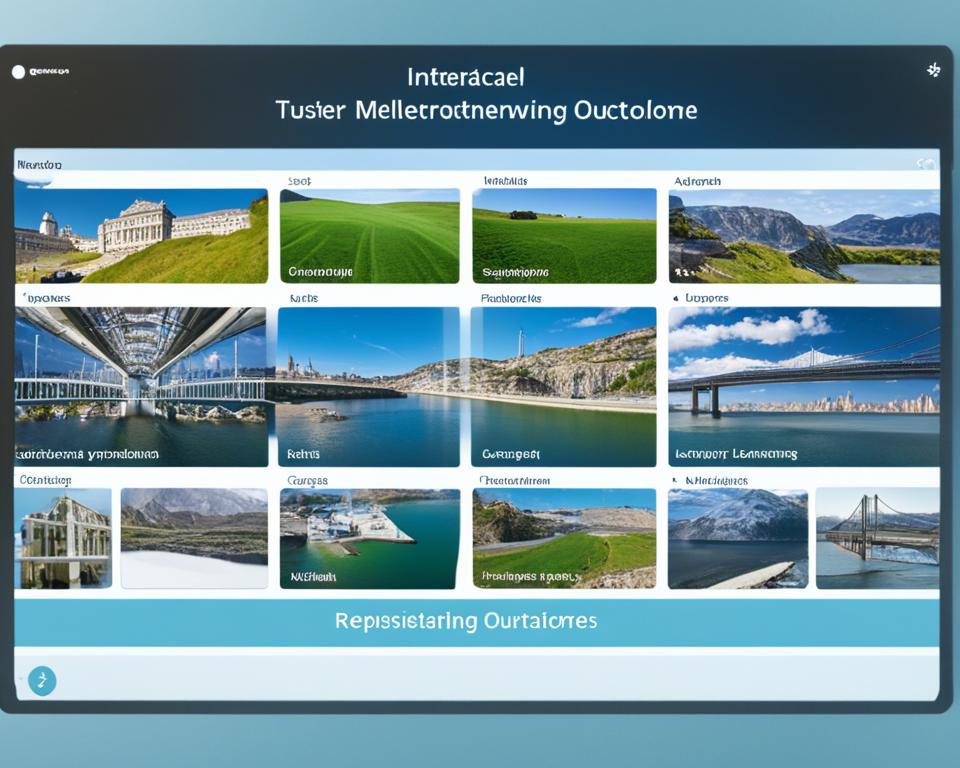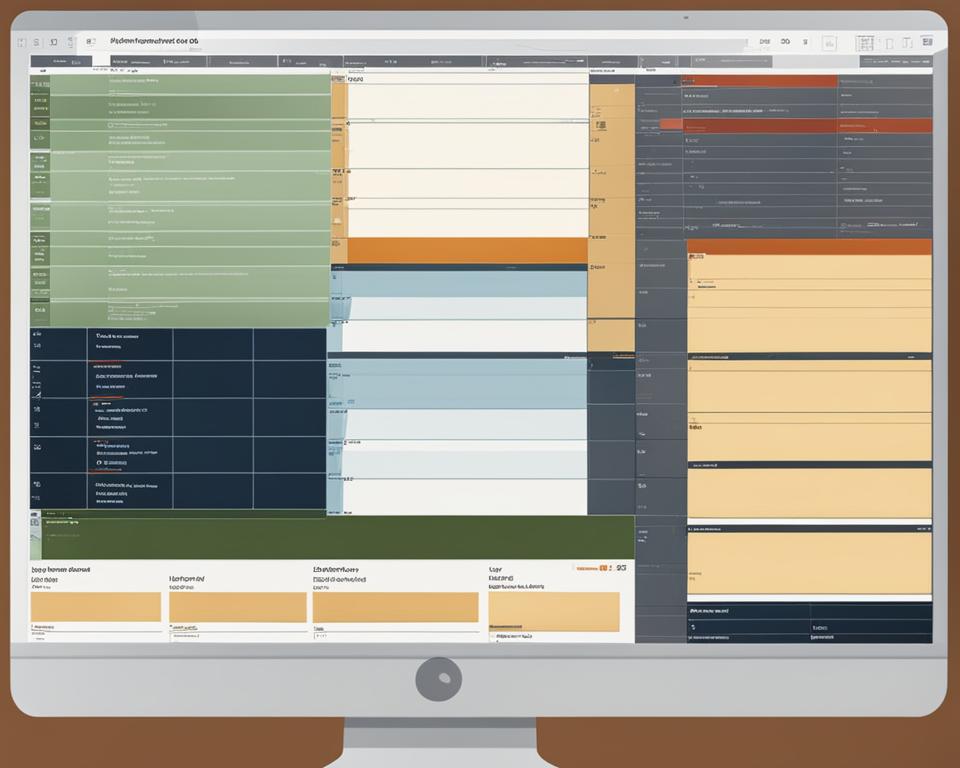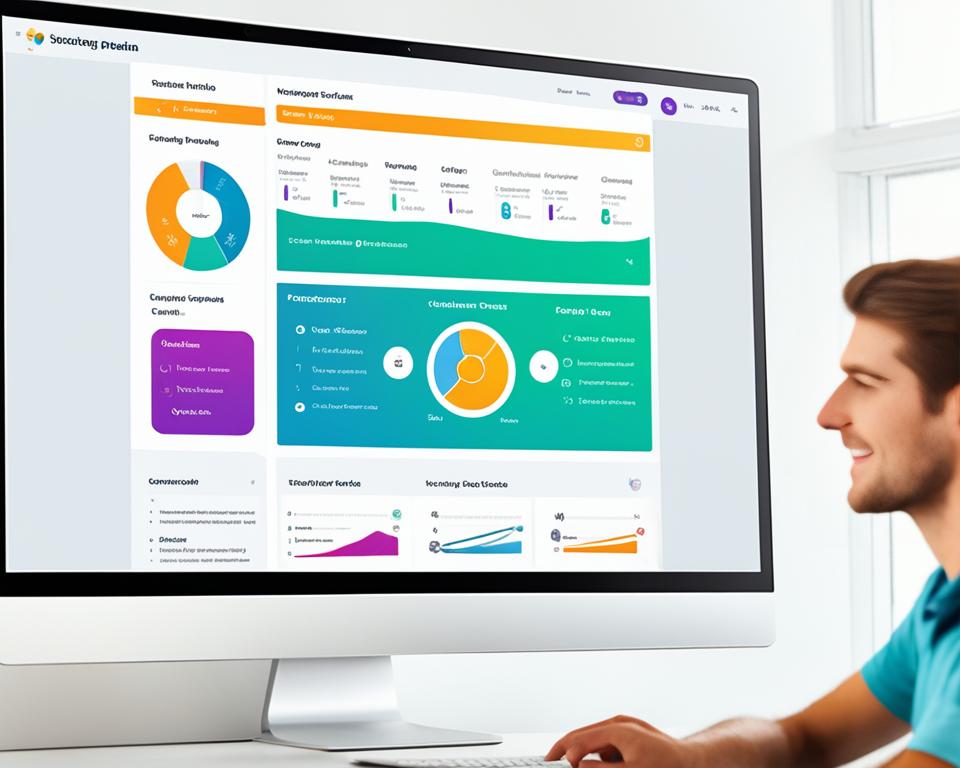Web-based learning modules have revolutionized online education, providing students with an interactive and personalized learning experience. These modules, also known as online educational modules or e-learning modules, have overcome the limitations of traditional classrooms by allowing students, teachers, and parents to stay connected from anywhere in the world. By partnering with a reputable education web app development company, educators can create cutting-edge e-learning web applications that meet the evolving needs of online classrooms. These web apps integrate innovative features and user-centric design to enhance the digital learning experience for both educators and students.
Key Takeaways:
- Web-based learning modules offer an interactive and personalized learning experience.
- Educators can partner with education web app development companies to create advanced e-learning web applications.
- These web apps enhance the digital learning experience for both teachers and students.
- Online educational modules allow students, teachers, and parents to stay connected from anywhere in the world.
- Web-based learning modules overcome the limitations of traditional classrooms.
What is an E-learning Web App?
An e-learning web app is a powerful tool that brings education to the digital realm, allowing learners to access educational content and activities through an internet connection. It provides a virtual learning environment that facilitates interactive learning experiences and offers flexibility for both educators and students. With the rise of online education, e-learning web apps have become an essential component of distance learning, enabling students to engage in learning activities from any location.
In an e-learning web app, learners can input data, interact with educational content, and receive immediate feedback, simulating the experience of a traditional classroom. This web-based platform offers a myriad of features that enhance the learning process, making it convenient, flexible, and accessible for learners at all levels.
| Benefits of an E-learning Web App: |
|---|
| • Access educational content and activities from anywhere |
| • Interactive learning experiences |
| • Immediate feedback and results |
| • Convenient and flexible learning environment |
| • Eliminates geographical barriers |
With the integration of e-learning web apps into online education, educators can create engaging and interactive virtual classrooms. These apps provide a variety of educational materials, interactive activities, and assessments that cater to different learning styles. By leveraging the power of technology, e-learning web apps offer a unique learning experience that promotes collaboration, critical thinking, and knowledge retention.
Now, let’s take a closer look at how an e-learning web app works and explore some of the must-have features that make these apps effective tools for online education.
Quote:
“E-learning web apps have revolutionized education by providing a virtual learning environment that breaks down traditional barriers and promotes interactive and engaging learning experiences.” – Dr. Emily Johnson, Education Specialist
How does an E-learning Web App Work?
E-learning web apps are an integral part of modern education, allowing students to access educational content and participate in interactive activities through the internet. These web-based platforms provide a virtually connected classroom, facilitating web-based training and fostering a virtual learning network. Students can access e-learning web apps from anywhere with an internet connection, enabling flexible and convenient learning experiences.
One example of a widely used e-learning web app is Zoom, which incorporates video conferencing capabilities to host virtual meetings. This real-time communication tool allows teachers and students to engage in interactive activities such as tests, responses, seminars, and math problem-solving, further enhancing the virtual learning experience.
In a virtually connected classroom, students can participate in interactive activities such as tests, responses, seminars, math problem-solving, and more.
Through e-learning web apps, students can actively engage with the course material and collaborate with their peers and teachers. These apps provide a wide range of interactive activities, including quizzes, discussions, and multimedia presentations, fostering an engaging and dynamic learning environment. Students can submit assignments, ask questions, and receive feedback, all within the virtual learning platform.
By leveraging web-based training, educators can create a comprehensive and interactive learning experience that promotes active participation, critical thinking, and collaboration. E-learning web apps enable students to access educational resources and interactive activities anytime and anywhere, empowering them to take charge of their own learning journey.

The Benefits of E-learning Web Apps and Web-Based Training:
- Access to educational content and resources from anywhere with an internet connection
- Flexible learning schedules that cater to individual needs and preferences
- Diverse and interactive activities for active engagement and participation
- Collaborative learning opportunities with peers and teachers
- Real-time communication and feedback through virtual meetings
- Convenient and cost-effective alternative to traditional classroom-based training
Must-have Features of an E-learning Web App or Online Learning Web App
To create an effective e-learning web app, there are several must-have features to consider.
- Learner-centric Web Layout: A learner-centric web layout prioritizes the needs and preferences of learners, providing them with a user-friendly and intuitive interface. This layout ensures easy navigation and access to learning materials, enhancing the overall learning experience.
- Responsive Designs: Responsive designs adapt to different devices, such as desktops, laptops, tablets, and smartphones. This allows learners to access the web app from any device and ensures a consistent and optimized experience across various screen sizes.
- Push Notifications: Push notifications play a crucial role in keeping learners engaged and informed. They can be used to send reminders, updates, and appreciations, helping learners stay motivated and on track with their learning goals.
- Variety of Learning Materials: A diverse range of learning materials, including visuals, videos, podcasts, and interactive elements, enriches the learning experience. These materials cater to different learning styles and preferences, making the content more engaging and dynamic.
- Micro-learning Concepts: Micro-learning refers to the delivery of bite-sized, focused lessons that are easy to digest and retain. Incorporating micro-learning concepts into the web app allows learners to access short and targeted learning modules, maximizing their learning potential.
- Downloadable Content: Providing downloadable online content gives learners the flexibility to access materials offline. This feature allows students to review and study course content at their convenience, even when they don’t have an internet connection.
- Multiple Quiz Formats: Engaging assessments are an integral part of the learning process. Including multiple quiz formats, such as multiple-choice, fill-in-the-blanks, and interactive quizzes, allows learners to assess their knowledge in an interactive and stimulating way.
By incorporating these must-have features, e-learning web apps can offer a learner-centric and immersive learning experience, fostering engagement and maximizing educational outcomes.
Top 15+ Interactive E-Learning Web Apps
There are numerous interactive e-learning web apps available for educators to enhance the online learning experience. These apps provide innovative features and functionalities that engage students and facilitate effective virtual classrooms. Some of the top choices include:
- Google Classroom: A powerful tool for organizing daily activities and conducting online classes.
- Kahoot: A game-based learning app that makes learning fun and interactive for students.
- Zoom Education: A video conferencing platform specifically designed for tutoring and communication between teachers and students.
- Seesaw: An app that enables teachers to showcase student progress and engage parents in the learning process.
- Photomath: An award-winning web app that helps students solve math problems step-by-step.
Other notable e-learning web apps include Socrative, Edmodo, Scratch, Prezi, Thinglink, Quizlet, Class Dojo, Storybird, Animoto, and Educreations. These apps offer a wide range of functionalities, such as interactive quizzes, collaborative projects, visual presentations, multimedia storytelling, and more, making them valuable resources for educators seeking to create engaging online learning environments.
“E-learning web apps provide educators with a wide range of interactive tools that enhance the online learning experience and engage students in new and exciting ways.”
With the diverse selection of e-learning web apps available, educators can choose the ones that best suit their teaching style and subject matter. These apps not only make learning enjoyable but also promote active participation and knowledge retention among students.
Next, let’s explore how an e-learning web app is built and the benefits of web-based training in the following sections.
How is an E-learning Web App Built?
Building an e-learning web app involves a well-defined process that combines creativity, technical expertise, and collaboration. Here are the key steps in the process:
Step 1: Understanding the Intention and Ideation
The first step in building an e-learning web app is to understand the intention behind it. The development team needs to have a clear understanding of the app’s purpose, target audience, and desired outcomes. By identifying these key aspects, the team can create a solid foundation for the app’s design and functionality. Market research is also essential to ensure that the app brings unique features and value to the user.
Step 2: Determining Features and Functionality
Once the intention is established, the next step is to determine the features and functionality of the e-learning web app. This involves brainstorming and defining the core components that will enable users to engage with the content effectively. For example, features like interactive quizzes, video lessons, progress tracking, and discussion forums enhance the learning experience.
Step 3: Coding and Design
After finalizing the app’s features, the development team starts coding and designing the e-learning web app. They use programming languages like HTML, CSS, and JavaScript to build the app’s user interface and ensure its responsiveness across different devices. The design phase involves creating visually appealing layouts that align with the app’s branding and provide an intuitive user experience.
Step 4: Testing and Debugging
Testing is a critical phase in the development process. It involves running various test scenarios to identify and resolve any bugs or issues in the app’s functionality. The development team conducts rigorous testing to ensure that all features work as intended and that the app provides a seamless experience for users. This process may involve debugging code, optimizing performance, and refining user interactions.
Step 5: Deployment and Collaboration
Once the app has passed all the necessary tests, it is ready for deployment. The development team collaborates with stakeholders, project managers, subject matter experts, instructional designers, and learning management system (LMS) administrators to ensure a smooth transition from development to production. Regular communication and collaboration throughout the process are crucial to create a successful e-learning web app.
The process of building an e-learning web app involves understanding the intention, determining features, coding and design, testing and debugging, and collaboration. A well-executed development process ensures a user-friendly and impactful e-learning experience.

| Step | Description |
|---|---|
| Step 1 | Understanding the Intention and Ideation |
| Step 2 | Determining Features and Functionality |
| Step 3 | Coding and Design |
| Step 4 | Testing and Debugging |
| Step 5 | Deployment and Collaboration |
Benefits of Web-Based Training
Web-based training offers numerous benefits that make it an ideal choice for both learners and organizations. Whether it’s professional development or educational courses, web-based training provides a flexible and cost-effective approach to learning. Let’s explore the advantages in more detail:
1. Flexibility for Learners
Web-based training allows learners to access educational content and resources at their own pace and convenience. With the flexibility to learn anytime and anywhere, employees can fit their training around their work and personal commitments. This flexibility not only enhances engagement but also promotes a sense of ownership and responsibility for learning.
2. Cost-Effectiveness
Traditional training methods often incur significant costs, including travel expenses, accommodation, and venue rentals. In contrast, web-based training eliminates these expenses by providing a virtual learning environment that can be accessed from anywhere with an internet connection. This cost-effectiveness makes web-based training a more affordable and sustainable option for organizations of all sizes.
3. Higher Learning Potential
Web-based training offers a higher learning potential by utilizing a variety of multimedia elements and interactive features. From videos and animations to quizzes and simulations, online courses can embed information through multiple channels, catering to different learning styles. This multi-dimensional approach enhances learning retention and allows learners to grasp complex concepts more effectively.
4. Effective Across All Disciplines
Web-based training is effective across all disciplines and can be tailored to meet specific industry needs. Whether it’s technical skills, compliance training, or soft skill development, the versatility of web-based training enables organizations to deliver targeted and relevant content to their employees. This flexibility ensures that training programs align with the goals and objectives of various industries.
5. Testimonials from Satisfied Learners
“Web-based training provided me with the flexibility to learn at my own pace and access resources whenever I needed them. The interactive nature of the courses helped me absorb the information better, and I could immediately apply what I learned in my job.”
Overall, web-based training offers learners a flexible, cost-effective, and highly effective learning experience across all disciplines. Its ability to adapt to different learning styles, coupled with the convenience it provides, makes it an ideal choice for organizations and individuals seeking to enhance knowledge and skills.
| Benefits of Web-Based Training |
|---|
| Flexibility for learners |
| Cost-effectiveness |
| Higher learning potential |
| Effective across all disciplines |
Web-Based Training Platforms for Education
Several web-based training platforms are available for educational purposes. These platforms offer a wide range of courses and resources to enhance the learning experience for students of all levels. Whether you’re a teacher looking to supplement your curriculum or an individual seeking self-paced learning opportunities, these platforms provide convenient and accessible options.
EdApp
EdApp specializes in microlearning and mobile learning, offering a wide range of self-paced microlearning courses for various industries. With bite-sized lessons that can be completed on the go, EdApp makes learning convenient and engaging.
Coursera
Coursera provides courses from top educational institutions and companies, offering certificates recognized by renowned universities. With a vast selection of subjects, learners can explore diverse topics and gain valuable skills.
Khan Academy
Khan Academy offers thousands of videos on different subjects for personalized learning. With a user-friendly interface and comprehensive content, Khan Academy caters to learners of all ages and backgrounds.
eDX
eDX is an online learning platform that partners with prestigious universities and organizations to offer high-quality courses. Learners can access a wide range of subjects and earn certificates to showcase their achievements.
GoSkills
GoSkills focuses on providing practical skills training for professionals. With courses designed for career advancement, GoSkills offers industry-relevant content to help learners stay competitive in the job market.
SkillShare
SkillShare is a community-driven platform that allows creators to share their expertise through video-based courses. With a focus on creativity and innovation, SkillShare offers a diverse range of classes for individuals seeking new skills and knowledge.
Gyrus
Gyrus is a comprehensive learning management system that supports online training and development. With features such as online assessments, progress tracking, and customizable learning paths, Gyrus provides organizations with the tools to deliver effective training programs.
AdaptiveU
AdaptiveU is an intelligent learning platform that utilizes adaptive technology to personalize the learning experience. By analyzing learner data and adjusting content accordingly, AdaptiveU ensures that each learner receives tailored and impactful instruction.
360Learning
360Learning offers a collaborative learning platform that encourages interaction and engagement among learners. With features such as social learning and real-time feedback, 360Learning creates a dynamic and interactive learning environment.
Agylia
Agylia is a mobile-first learning platform that enables organizations to deliver learning content on any device. With features such as offline access and gamification, Agylia makes learning accessible and enjoyable for learners on the go.
These web-based training platforms provide educators and learners with an array of options to enhance the educational experience. Whether you’re looking for self-paced courses, interactive learning environments, or industry-specific training, these platforms offer the tools and resources to support your educational goals.
Conclusion
Web-based learning modules have revolutionized education by providing innovative and engaging learning experiences. Through e-learning web apps, students can now access educational content and activities from anywhere in the world. With a plethora of interactive web apps available, educators have the tools they need to create dynamic virtual classrooms and enhance students’ learning experiences.
The integration of web-based learning modules and online platforms has opened up new possibilities for interactive and personalized learning. Students can now engage with digital learning modules and participate in online courses, expanding their knowledge and skills in virtual classrooms. These web-based training modules have truly transformed the educational landscape, offering flexibility and convenience for both educators and learners.
By embracing web-based learning modules and e-learning web apps, educational institutions can provide students with a rich and interactive learning environment. The seamless integration of technology into education not only enhances the learning experience but also prepares students for the digital world they will navigate in their future careers. As web-based learning continues to evolve, the opportunities for online educational modules and virtual learning modules will only expand, enabling educators to deliver quality education to students across the globe.
FAQ
What are web-based learning modules?
Web-based learning modules, also known as online educational modules or e-learning modules, are interactive online modules that provide students with a personalized learning experience. They have transformed online education by allowing students, teachers, and parents to stay connected from anywhere in the world.
What is an e-learning web app?
An e-learning web app is an interactive webpage that allows learners to access educational content and activities through an internet connection. It provides a virtual learning environment where students can interact with the content, input data, and receive expected results. This web-based platform enables students to engage in learning activities from any location, making it convenient and flexible.
How does an e-learning web app work?
E-learning web apps are stored on a web server and can be accessed by students through a web browser with an active internet connection. These apps enable students to participate in interactive activities such as tests, responses, math problem-solving, and seminars in a virtually connected classroom. For example, video conferencing software like Zoom Education enables real-time learning interactions by hosting virtual meetings.
What are the must-have features of an e-learning web app?
An effective e-learning web app should have a learner-centric web layout with responsive designs, push notifications for reminders and appreciations, a variety of learning materials such as visuals, videos, and podcasts, micro-learning concepts for bite-sized lessons, downloadable online content for convenient review, and multiple quiz formats for engaging assessments.
What are some top interactive e-learning web apps?
Some top interactive e-learning web apps include Google Classroom, Kahoot, Zoom Education, Seesaw, Photomath, Socrative, Edmodo, Scratch, Prezi, Thinglink, Quizlet, Class Dojo, Storybird, Animoto, and Educreations. These web apps offer various features to enhance the online learning experience for both students and teachers.
How is an e-learning web app built?
Building an e-learning web app involves understanding the app’s intention, conducting market research, determining the features and functionality, coding and design, testing and debugging, and collaboration between stakeholders, project managers, subject matter experts, instructional designers, and LMS administrators.
What are the benefits of web-based training?
Web-based training offers the benefits of flexibility, cost-effectiveness, higher learning potential, and effectiveness across all disciplines. Learners can learn at their own pace and in their ideal environment, reducing travel expenses and disruptions to regular business operations. The embedding of information in web-based training accommodates different learning styles and provides a wide range of training possibilities for various industries.
What are some web-based training platforms for education?
Some notable web-based training platforms for education include EdApp, Coursera, Khan Academy, eDX, GoSkills, SkillShare, Gyrus, AdaptiveU, 360Learning, and Agylia. These platforms offer self-paced courses, certificates recognized by renowned universities, personalized learning videos, and industry-specific training.





